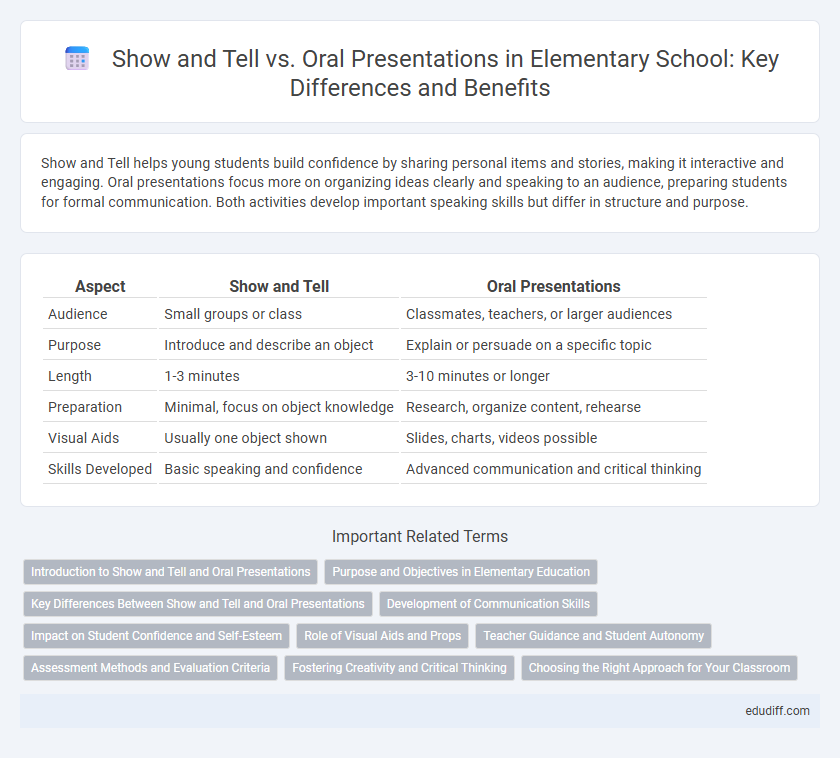Show and Tell helps young students build confidence by sharing personal items and stories, making it interactive and engaging. Oral presentations focus more on organizing ideas clearly and speaking to an audience, preparing students for formal communication. Both activities develop important speaking skills but differ in structure and purpose.
Table of Comparison
| Aspect | Show and Tell | Oral Presentations |
|---|---|---|
| Audience | Small groups or class | Classmates, teachers, or larger audiences |
| Purpose | Introduce and describe an object | Explain or persuade on a specific topic |
| Length | 1-3 minutes | 3-10 minutes or longer |
| Preparation | Minimal, focus on object knowledge | Research, organize content, rehearse |
| Visual Aids | Usually one object shown | Slides, charts, videos possible |
| Skills Developed | Basic speaking and confidence | Advanced communication and critical thinking |
Introduction to Show and Tell and Oral Presentations
Show and Tell and Oral Presentations are key speaking activities in elementary education that develop communication skills and confidence. Show and Tell encourages students to describe a personal item, promoting storytelling and vocabulary use, while Oral Presentations require organizing information on a topic to inform or persuade an audience. Both methods enhance public speaking, listening abilities, and critical thinking in young learners.
Purpose and Objectives in Elementary Education
Show and Tell in elementary education encourages young students to develop communication skills by sharing personal items, fostering confidence and vocabulary growth. Oral presentations focus on organizing ideas and delivering clear messages to an audience, enhancing public speaking and critical thinking abilities. Both methods aim to build foundational language skills and boost self-expression in young learners.
Key Differences Between Show and Tell and Oral Presentations
Show and Tell involves students bringing an object to share and describe, making it interactive and personal, while Oral Presentations require delivering structured information on a specific topic without props. Show and Tell emphasizes storytelling and personal experience, promoting confidence in speaking to small groups. Oral Presentations focus on clear organization, research skills, and formal communication in front of larger audiences.
Development of Communication Skills
Show and Tell activities promote early communication skills by encouraging children to describe objects and express personal experiences, fostering vocabulary growth and confidence in speaking. Oral Presentations develop advanced skills such as organizing ideas, practicing public speaking, and engaging an audience effectively. Both methods enhance listening abilities and nonverbal communication, essential for comprehensive language development in elementary students.
Impact on Student Confidence and Self-Esteem
Show and Tell activities boost elementary students' confidence by allowing them to share personal stories and objects in a supportive environment, fostering positive self-expression. Oral presentations challenge students to organize and deliver information clearly, enhancing public speaking skills and self-assurance in academic settings. Both formats contribute to improved self-esteem by encouraging active participation and recognition from peers and teachers.
Role of Visual Aids and Props
Visual aids and props in Show and Tell enhance student engagement by providing tangible objects that support verbal explanations, making concepts easier to understand. In oral presentations, visual aids such as slides or charts help organize information and emphasize key points, aiding audience comprehension. Both methods utilize visuals to reinforce communication, but Show and Tell relies more on physical props, while oral presentations focus on graphical or digital supports.
Teacher Guidance and Student Autonomy
Effective teacher guidance in show and tell supports young learners by modeling descriptive language and encouraging personal expression, while oral presentations require teachers to facilitate research skills and structured speaking practice. Student autonomy increases during oral presentations as children plan content, organize ideas, and develop confidence independently, contrasting with the more teacher-directed format of show and tell. Balancing guidance and autonomy in both formats enhances communication skills and fosters classroom confidence in elementary students.
Assessment Methods and Evaluation Criteria
Show and Tell assessments focus on students' ability to clearly describe and engage with a concrete object, emphasizing verbal expression, vocabulary use, and confidence. Oral presentations are evaluated based on structure, content accuracy, audience engagement, clarity of speech, and use of visual aids. Both methods assess communication skills, but oral presentations require deeper organization and critical thinking in delivering information.
Fostering Creativity and Critical Thinking
Show and Tell enhances creativity by encouraging students to express ideas through personal stories and objects, fostering imaginative thinking. Oral presentations develop critical thinking skills as students organize information, analyze topics, and articulate arguments clearly. Both methods promote communication skills but Show and Tell emphasizes personal connection, while oral presentations emphasize structured reasoning.
Choosing the Right Approach for Your Classroom
Choosing the right approach for your elementary classroom depends on your students' comfort level and communication skills. Show and Tell encourages young learners to practice speaking by sharing personal items, fostering confidence and creativity. Oral presentations develop structured speaking abilities and organization, preparing students for more formal communication tasks.
Show and Tell vs Oral Presentations Infographic

 edudiff.com
edudiff.com